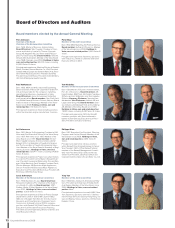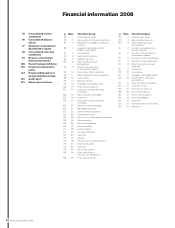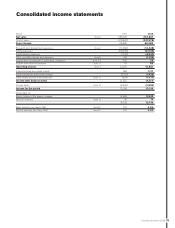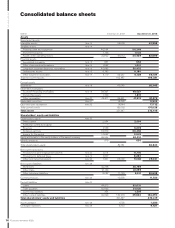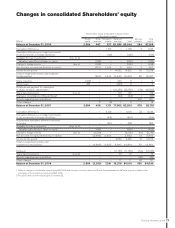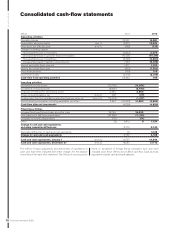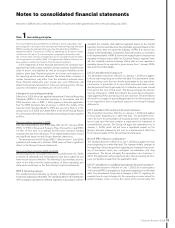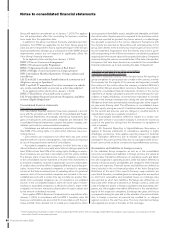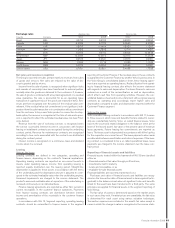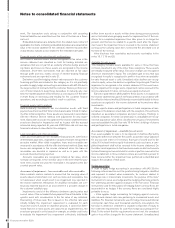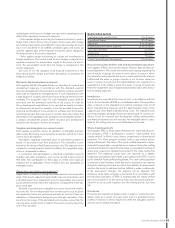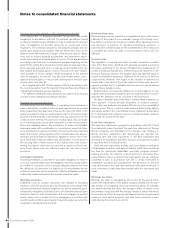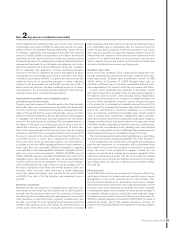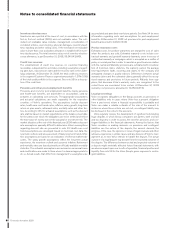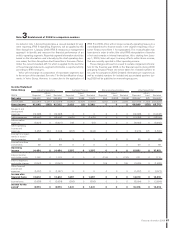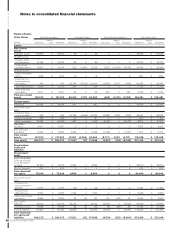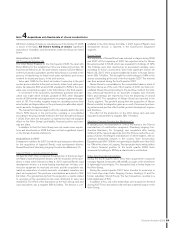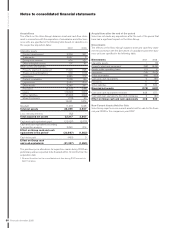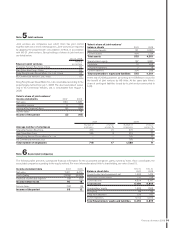Volvo 2008 Annual Report Download - page 86
Download and view the complete annual report
Please find page 86 of the 2008 Volvo annual report below. You can navigate through the pages in the report by either clicking on the pages listed below, or by using the keyword search tool below to find specific information within the annual report.
Notes to consolidated fi nancial statements
82
THE VOLVO GROUP
Financial information 2008
ment. The transaction costs arising in conjunction with assuming
fi nancial liabilities are amortized over the term of the loan as a fi nan-
cial cost.
Embedded derivatives are detached from the related main contract, if
applicable. Contracts containing embedded derivatives are valued at fair
value in the income statement if the contracts’ inherent risk and other
characteristics indicate a close relation to the embedded derivative.
Financial assets at fair value through profi t and loss
All of Volvo’s fi nancial assets that are recognized at fair value in the
income statement are classifi ed as held for trading. Included are
derivatives that are not part of an evidently effective hedge account-
ing. Gains and losses on these assets are recognized in the income
statement. Short-term investments that are reported at fair value
through profi t and loss mainly consist of interest-bearing fi nancial
instruments and are reported in note 21.
Derivatives used for hedging interest-rate exposure in the customer
fi nancing portfolio are included in this category as it is not practically
possible to apply hedge accounting in accordance with IAS 39 due to
the large number of contracts that the customer fi nance portfolio con-
sist of. Volvo intends to keep these derivatives to maturity, why, over
time, the market valuation will be offset as a consequence of the inter-
est-rate fi xing on borrowing and lending for the customer fi nance
operations, and accordingly not affect result or cash fl ow.
Financial assets held to maturity
Held-to-maturity investments are non-derivative assets with fi xed
payments and term and that Volvo intends and is able to hold to matur-
ity. After initial recognition, these assets are measured in accordance
with the effective interest method, with adjustment for any impair-
ment. Gains and losses are recognized in the income statement when
assets are divested or impaired as well as in pace with the accrued
interested being reported. At year end 2008 Volvo did not have any
fi nancial instruments classifi ed in this category.
Loan receivables and other receivables
Loans and receivables are non-derivative fi nancial assets with fi xed or
determinable payments, originated or acquired, that are not quoted in
an active market. After initial recognition, loans and receivables are
measured in accordance with the effective interest method. Gains and
losses are recognized in the income statement when the loans or
receivables are divested or impaired as well as in pace with the
accrued interested being reported.
Accounts receivables are recognized initially at fair value, which
normally corresponds to the nominal value. In the event that the pay-
ment terms exceed one year, the receivable is recognized at the dis-
counted present value.
Assessment of impairment – loan receivables and other receivables
Volvo conducts routine controls to ensure that the carrying value of
assets valued at amortized cost, such as loans and receivables, has
not decreased, which would result in an impairment loss reported in
the income statement. Allowances for doubtful receivables are con-
tinuously reported based on an assessment of a possible change in
the customer’s ability to pay.
Impairments consist of the difference between carrying value and
current value of the estimated future payment fl ow attributable to the
specifi c asset with consideration to the fair value of any collateral.
Discounting of future cash fl ow is based on the effective rate used
initially. Initially, the impairment requirement is evaluated for each
respective asset. If, based on objective grounds, it cannot be deter-
mined that one or more assets are subject to an impairment loss, the
assets are grouped in units based, for example, on similar credit risks
to evaluate the impairment loss requirement collectively. Individually
written down assets or assets written down during previous periods
are not included when grouping assets for impairment test. If the con-
ditions for a completed impairment loss later prove to no longer be
present, and that can be related to a specifi c event after the impair-
ment event, the impairment loss is reversed in the income statement
as long as the carrying value does not exceed the amortized cost at
the time of the reversal.
Volvo discloses loan receviables and accounts receivables in the
notes 16, 17, 19 and 20.
Available-for-sale assets
This category includes assets available for sales or those that have
not been classifi ed in any of the other three categories. These assets
are initially measured at fair value. Fair value changes are recognized
directly in shareholders’ equity. The cumulative gain or loss that was
recognized in equity is recognized in profi t or loss when an available-
for-sale fi nancial asset is sold. Unrealized value declines are recog-
nized in equity, unless the decline is signifi cant or prolonged. Then the
impairment is recognized in the income statement. If the event caus-
ing the impairment no longer exists, impairment can be reversed in the
income statement if it does not involve an equity instrument.
Earned or paid interest attributable to these assets is recognized in
the income statement as part of net fi nancial items in accordance with
the effective interest method. Dividends received attributable to these
assets are recognized in the income statement as Income from other
investments.
Volvo reports shares and participations in listed companies at mar-
ket value on the balance-sheet date, with the exception of investments
classifi ed as associated companies and joint ventures. Holdings in
unlisted companies for which a market value is unavailable are recog-
nized at acquisition value. Volvo classifi es these types of investments
as assets available for sale. See note 15 for Volvo’s holdings of shares
and participations in listed companies.
Assessment of impairment – available-for-sale assets
If an asset available for sale is to be impaired, it shall be effected by
taking the difference between the asset’s acquisition value (adjusted
for any accrued interest if it involves that type of asset) and its fair
value. If it instead involves equity instruments such as shares, a com-
pleted impairment shall not be reversed in the income statement. On
the other hand, impairments that have been made on debt instruments
(interest-bearing instruments) shall in whole or part be reversed in the
income statement, in those instances where an event that is proven to
have occurred after the impairment was performed is identifi ed and
impacts the valuation of that asset.
Hedge accounting
In order to apply hedge accounting in accordance with IAS 39, the
following criteria must be met: the position being hedged is identifi ed
and exposed to market value movements, for instance related to
exchange-rate or interest-rate movements, the purpose of the loan/
instrument is to serve as a hedge and the hedging effectively protects
the underlying position against changes in the fair value. Financial
instruments used for the purpose of hedging future currency fl ows are
accounted for as hedges if the currency fl ows are considered highly
probable to occur.
– Volvo applies hedge accounting for hedging against currency-
rate risk and interest-rate risks pertaining to commercial assets and
liabilities. For fi nancial instruments used to hedge forecasted internal
commercial cash fl ows and forecasted electricity consumption, the
fair value is debited or credited to a separate component of equity to
the extent the requirements for cash-fl ow hedge accounting are ful-
fi lled. To the extent that the requirements are not met, the unrealized
gain or loss will be charged to the income statement. Unrealized and


